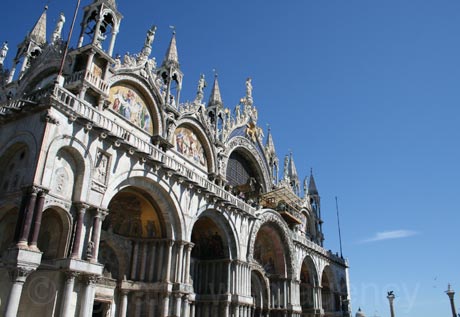Saint Mark’s Basilica

Next to the Doge’s Palace, the Saint Mark’s Basilica (officially referred to as the Patriarchal Cathedral Basilica of Saint Mark – or, in Italian, Basilica Cattedrale Patriarcale di San Marco) stands out as the most iconic architectural landmark of Venice. Yet, it’s not just the architectural merits and the lavishness of the decorations (both interior and exterior) that hint on the connection between the celebrated Palazzo Ducale and the basilica. We also speak of a centuries-old historical background which closely links the basilica to the Ducal Palace.
Originally, a place of worship dedicated to Saint Mark the Evangelist was built inside the Doge’s Palace, serving as chapel for the palace. It was precisely here that the relics of the saint were sheltered after being brought (stolen, by some historians’ account and as the legend goes) from Alexandria in 828 (this is also the date when Venice changed its patron saint, replacing Saint Theodore with Saint Mark). However, the original church dedicated to Saint Mark was destroyed and completely rebuilt in 832, only to be again rebuilt in the 10th century (976). That last building was also raised to the ground, such that the 11th century brought the carrying out of new construction works at what stands out today, in its general outline and all its glory, as the Saint Mark’s Cathedral. The edifice was consecrated in 1094, and it was granted the title of cathedral no sooner than 1807.
The imposing Byzantine structure also features striking Gothic elements, but the Byzantine influence prevails on all the other stylistic insertions (plenty of them, for that matter, which is no surprise, given both the age of the building and the fact the basilica has constantly been enriched with decorative and structural additions, most of the noblemen, merchants and statesmen of Venice cultivating, in the course of history, the ambition of contributing to the patrimony of their dearest and most historic temple).
Overlooking the superb Piazza San Marco, and neighboring on the Doge’s Palace and on the Saint Mark’s Bell Tower, the Saint Mark’s Basilica was dubbed Chiesa d’Oro (the Church of Gold), driving at the decorative (and not only) richness of the edifice. On the outside, the basilica fetches by its onion-shaped domes (a visible influence of the Byzantine style architecture) and by the columns which flank the facade. The columns are covered with polychrome marble. Virtually the entire lower level of the basilica is covered with mosaics chiefly depicting religious scenes (some inspired from the life of Saint Mark) which, even if repeatedly replaced in the course of history due to their poor state (only few parts of these wide mosaics have managed to survive in their original shape), they kept the initial topics.
Yet, the most striking elements of the exterior basilica refer to the Greek Horses (Loggia dei Cavalli) placed on the upper level. The present exhibits are, of course, replicas, the original gilded bonzes being displayed inside Museo Marciano (La Galleria) (the admission to the museum is paid separately). We speak of several antique statues with no known authorship or period of creation. They used to embellish the Hippodrome of Constantinople for a long time, but they were shipped to Venice in 1204 as part of the spoils from the fourth crusade (together with the Lyon of Saint Mark, also visible from the outside). They were placed on the basilica 50 years later, then lifted away by the French troops during the Napoleonic regime (in 1797) only to be brought back to Venice in 1815.
Another strange sculptural highlight refers to the so-called Tetrarch, reminiscent of the medieval institution of tetrarchy. It too was part of the spoils brought to Venice in the early 13th century, together with the Greek Horses and the Lyon.
The interior of the basilica is of special magnificence. The floors, the lower side of the walls and of the columns are covered with polychrome marble, the rest of the basilica (ceiling and the upper side of the walls and columns) being covered with mosaics of gold and bronze. The entire surface covered by the mosaic amounts to 8,500 square meters. But a definite highlight of the interior refers to the so-called Pala d'Oro (the Golden Pall), the altarpiece in the east wing of the basilica, one of the finest examples of Byzantine craftsmanship in the world (in order to be able to see this masterpiece, visitors must pay a separate fee). A visit to the basilica’s Treasury (Tesoro), which exhibits the spoils brought by the Venetians following the crusades, is also worth paying (the admission to the Treasury is also paid separately). Tourists might also make time to study and admire the so-called Madonna di Nicopeia, a 10th century Byzantine icon richly decorated with precious stones, valuable for the artistry of the work, and, of course, for its decorations. It is located in the left transept of the church.
The admission to the basilica is free of charge (except for Museo Marciano, Pala d’Oro, Treasury and, of course, the Bell Tower). For guided group tours, visitors are advised to make reservations.
- Name:
- Saint Mark’s Basilica (Basilica di San Marco)
- Address:
- 328, San Marco, 30124, Venice, Italy
- Telephone:
- 0039 041 2708334 / 0039 041 2413817
- Email:
- [email protected]
- Website:
- www.basilicasanmarco.it
- Opening hours:
- daily: 9:45am to 5pm; Sundays and holidays: 2pm to 5pm
 Saint Mark's Basilica Side View
Saint Mark's Basilica Side View